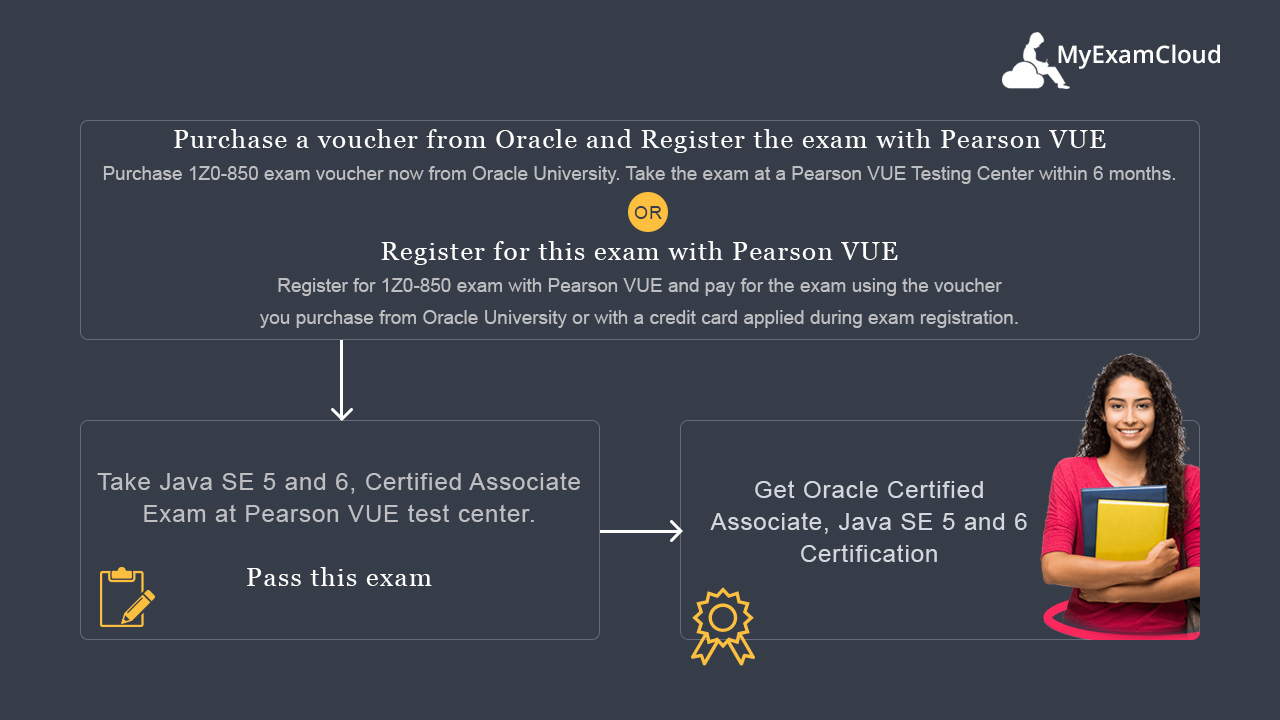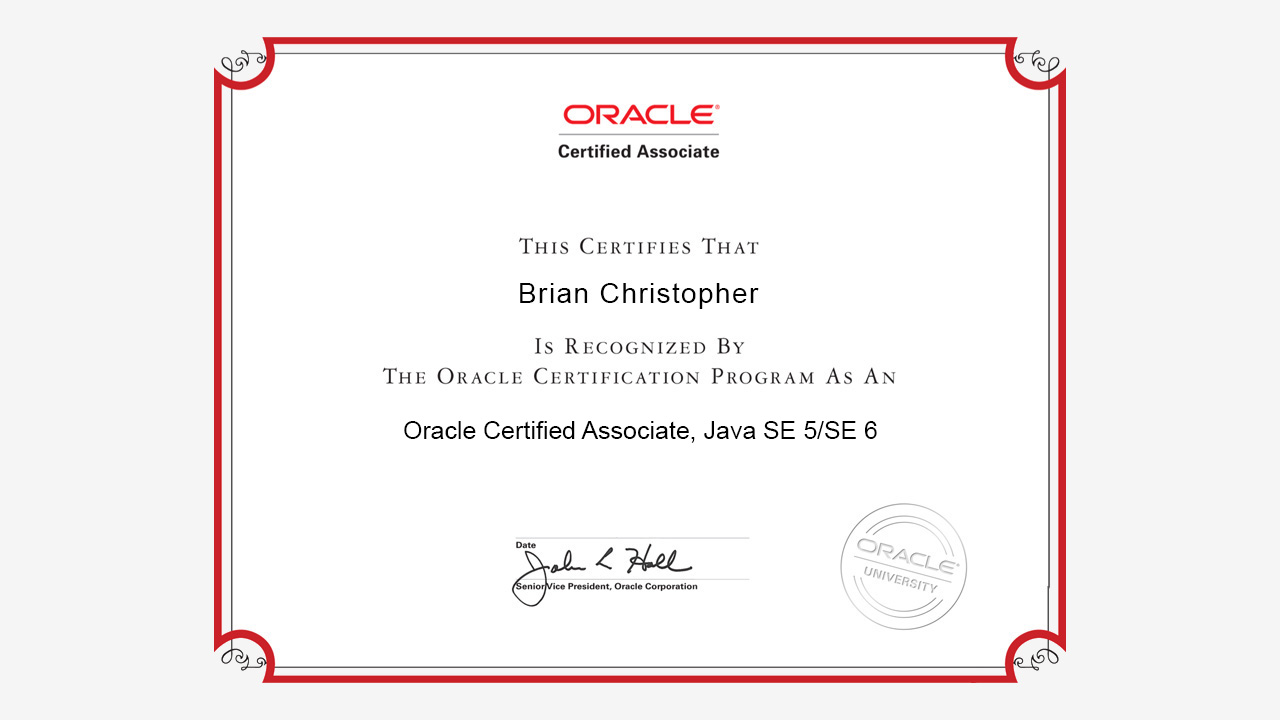16 OCAJ 6 Practice Questions - Free
You can access 16 Oracle Certified Associate Java SE 5/SE 6 Practice Questions, from MyExamCloud Exam Simulator
Take Free Practice Testfor Oracle Certified Associate Java SE 5/SE 6 Certification
MyExamCloud OCAJ 6 Practice Tests helps you to pass the exam in first attempt. Prepare with one of the best OCAJ 6 Study Course developed by Java Certified Experts. 100% Test Pass Guarantee.
OCPJP 8 Upgrade (All Versions) Practice Tests and eBooks are available online at MyExamCloud Exam Simulator. This course contents can be accessed from PC, Mac, iPhone®, iPad®, Android™ Device. Mobile Apps available on iTunes and Android stores.
Inside MyExamCloud's OCAJ 6 Practice Course
Set Goals on OCAJ 6 exam topics
(MyExamCloud PPA Tracker)
4 Full length mock exams
(MyExamCloud Practice Exams)
1 Free Trial mock exam
(MyExamCloud Practice Exam)
1 Quiz Exams
(MyExamCloud Quiz Exams)
4 Flash Card Quiz Exams
(MyExamCloud Quiz Exams)
2 Study Notes
(MyExamCloud eBooks)
Study mode to access topic based questions
Exhaustive explanation with every question
Reports to assess performance history, strengths & weaknesses
Track your goals
Focus lab to pinpoint your weak areas
Unlimited lifetime Access
The OCAJ 6 Practice Questions and study notes are created by highly qualified and Java Certified experts. The Authors has created this online course covering all Java SE 5 and 6, Certified Associate exam objectives based on latest Oracle's changes.
The OCPJP 6 certification improves object-orientated programming and Java fundamental skills.

Passing this exam, one can achieve Java SE 5 and SE 6, Certified Associate from Oracle. The real exam tests your OO and Java SE 6 skills by Single and Multiple choice questions. This exam also tests Java EE and Java ME basic skills required for senior leads.
| Number of Questions: | 51 Questions |
|---|---|
| Exam Duration | 115 Minutes |
| Passing Score: | 68% |
| Exam Format | Multiple Choice (which can have single or multiple answers) |
| Validated Against | Java SE 5 and SE 6 |
| Exam Price | Price May vary from Country to country. Refer Oracle site for latest pricing. |
The real exam is a computer based test provided by pearsonvue and it can be taken from any local test centers in your country.
Learn Java Skill to manage a Project: Learn high level overview of Java SE, Java ME and Java EE platforms.
The following practice question is taken from MyExamCloud OCAJ 6 Study Plan.
|
Question: Which Java technology can extend the capabilities of servers that host applications accessed via a request-response programming? ChoicesChoice A: EJB Choice B: MIDlet Choice C: Servlet Choice D: Swing |
Answer and Explanation:Choice C is correctServlet is a Java programming language class used to extend the capabilities of servers. Servlets can respond to any type of request, they are commonly used to extend the applications hosted by Web servers. |
You can access 16 Oracle Certified Associate Java SE 5/SE 6 Practice Questions, from MyExamCloud Exam Simulator
Take Free Practice TestWithin 30 minutes of completing your OCAJ 6 Certification exam, you will receive an email from Oracle notifying you that your exam results are available in CertView. If you have previously authenticated your CertView account, simply login and select the option to "See My New Exam Result Now."
If you have not authenticated your CertView account yet at this point, you will need to proceed with your account authentication.
Authentication requires an Oracle Single Sign On username and password and the following information from your Pearson VUE profile: email address and Oracle Testing ID. You will be taken to CertView to log in once your account has been authenticated.

The reason for taking Oracle Java Certification is to differentiate general programmers from certified experts. You may get additional benefits like getting a good job, salary hike, designation changes, role changes and higher promotion.
Stand out from the millions of Java crowd. Increase your marketability with OCAJ 6 Certification on the most used programming language in the world - Java.
Clear evidence that you can enter into an application development or a software project management career using Java technologies.
The certification empowers in driving Object-Oriented Concepts, UML representation of OO concepts, the Java programming language, and general knowledge of Java Platforms and Technologies.
Being a SCJA/OCAJ certified developer helps you to improve your career potential, gain more respect, and boost up your job security and opportunities.
With SCJA/OCAJ certified professional, you become more competitive in the job market.
Related Articles: https://www.epractizelabs.com/myexamcloud/2017/04/20/oracle-java-certification-exam-preparation/
Congrats, you have successfully scheduled your Java Certification exam.
The real exam questions assumes the following:
Missing package and import statements: If sample code do not include package or import statements, and the question does not explicitly refer to these missing statements, then assume that all sample code is in the same package, or import statements exist to support them.
No file or directory path names for classes: If a question does not state the file names or directory locations of classes, then assume one of the following, whichever will enable the code to compile and run:
Unintended line breaks: Sample code might have unintended line breaks. If you see a line of code that looks like it has wrapped, and this creates a situation where the wrapping is significant (for example, a quoted String literal has wrapped), assume that the wrapping is an extension of the same line, and the line does not contain a hard carriage return that would cause a compilation failure.
Code fragments: A code fragment is a small section of source code that is presented without its context. Assume that all necessary supporting code exists and that the supporting environment fully supports the correct compilation and execution of the code shown and its omitted environment.
Descriptive comments: Take descriptive comments, such as "setter and getters go here," at face value. Assume that correct code exists, compiles, and runs successfully to create the described effect.
|
Section 1: Fundamental Object-Oriented Concepts
Section 2: Java Implementation of Object-Oriented Concepts
Section 3: Algorithm Design and Implementation
Section 4: Java Development Fundamentals
Section 5: Java Platforms and Integration Technologies
Section 6: Client Technologies
Section 7: Server Technologies
|

I have completed SCJA and SCJP exams. I swear by your products and as an certified Java programmer, I regularly recommend your software as THE preparation standard for java certifications! Keep up the excellent work!